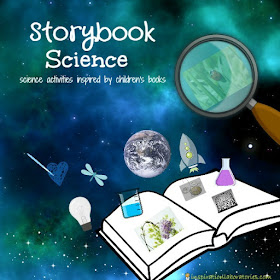I'm excited to be participating in Inspiration Laboratory's Storybook Science series again this year! This time around we're exploring conservation with a children's book and science activity.
We make a lot of trash! When we throw something away...where exactly is away? Your students and children will gain a better understanding of where trash goes and what happens in a landfill by building this landfill model.
Here Comes the Garbage Barge! is a great picture book to begin thinking about the problem of having too much trash. A great read and project for Earth Day!
This post contains affiliate links, please see disclosures for more information.
Read Here Comes the Garbage Barge!
Here Comes the Garbage Barge! is the fictionalized, but true, story of a barge full of trash that no one wanted. During the late 1980's Long Island's landfills were overflowing. Eventually the government stepped in and outlawed further burying of trash. So, it was decided the trash would be shipped to the south.
Here Comes the Garbage Barge! humorously tells the tale of colorful Cap'm Duffy St. Pierre and his tugboat and barge. As the garbage barge travels south word spreads and everyone is ready to turn poor Cap'm Duffy away. The adventure that ensues is funny, but also clearly illustrates the point that we create too much trash and no one wants to have to take care of it.
In addition the the subtle conservation message, the story serves as a great geography lesson. The interesting illustrations were created by making models and photographing the images. Much of the material used to make the models was repurposed trash.
Build a Landfill Model
Where does our trash go? If it is not reused, recycled or composted, in most cases, waste heads to the landfill. A landfill is much more than a pile of trash. Learn more about the anatomy of a landfill here. You can build the model below to better understand what a landfill is like. Once you understand landfills better, I bet you'll want to recycle even more! You will be able to observe your model over time to see how the trash in a landfill changes (or stays the same).There are many layers to the landfill. To make your model you'll need the following:
- an empty plastic bottle
- soil (from outside, or potting soil)
- clay, or play dough (make your own with this recipe)
- plastic wrap (or clear plastic headed for the trash)
- cotton balls
- gravel (from outside, or aquarium gravel)
- trash from the recycling, trash can or compost bin
- small plants or grass seed (optional)
- printable tutorial and student worksheets
Your first step will be to cut the top off of the plastic bottle. This will be the container you build your model in.
The first layer of your landfill will be soil. The base of the landfill is the natural soil of the land that the landfill is placed on. Because of this, great care is taken to be sure that any toxins in runoff water, or leachate, from the garbage do not end up in the native soil and ultimately in groundwater.
The next layer is compacted clay, or play dough for your model. The clay in an actual landfill provides another barrier to prevent leachate from entering the groundwater. It also helps gases to escape from the landfill.
The third layer of the model, plastic wrap, represents the geomembrane, a thin plastic sheet that again serves to prevent leachate from draining from the landfill. Do you sense a pattern? Leachate is nasty stuff!
You'll use cotton balls, spread thin, to represent the next layer of the landfill, the geotextile layer. This is part of a system that in an actual landfill uses pipes (not included in the model) to separate solids and liquids in the runoff from the landfill. The geotextile fabric prevents the pipes from getting clogged.
The fifth layer is a layer of gravel. The gravel layer is what collects the leachate as it originally exits the landfill's trash.
Once a landfill has reached a specified height, it is closed off. There is another layer of clay added to the top of the last trash/soil layer.
Another geomembrane, or in our case, plastic wrap, is added.
After the plastic geomembrane is another layer of gravel that serves as drainage.
The landfill is topped off with soil and grass. We used some houseplants, but to be even more accurate, you can plant some grass seed in your topsoil.
Voila! Now watch your model. See if you can answer the following questions in the next days, weeks and months.
- What happens to the trash over time?
- Do you notice anything changing?
- Can air and water get all the way through your model?
- How is this like a real landfill?
- What pieces of trash could have been recycled or composted?
Why is it important to reduce, reuse, and recycle? So that our planet doesn't run out of space! Who wants to live surrounded by trash anyway?
For a printable photo tutorial that includes student worksheets for further landfill model observations click here.
To see all of the great posts in the Storybook Science series, head on over to Inspiration Laboratories!

































